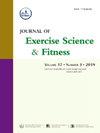Factors associated with physical fitness and disparities in population segments among older adults: A cross-sectional study
IF 2.4
2区 医学
Q2 SPORT SCIENCES
引用次数: 0
Abstract
Objectives
This study aimed to investigate the factors associated with physical fitness and disparities in population segments among older adults, using data from the National Physical Fitness Surveilling Survey of China.
Study design
A cross-sectional study.
Methods
A total of 13524 older adults aged 60–79 years were involved in the study. Participants completed physical fitness assessments encompassing body fat percentage, lung capacity, high leg raise in place, grip strength, seated forward bending, 30-s sit-to-stand test, single-leg standing with eyes closed, and choice reaction time. A profile analysis model was constructed by feature extraction, label design and clustering using principal component analysis and k-prototypes. Factors associated with physical fitness were analyzed using ordered probit regression, and within-group differences were evaluated through the bootstrap method.
Results
The older adults were categorized into four clusters based on the clustering results (Cluster I: n = 2728, Cluster II: n = 6067, Cluster III: n = 4189, Cluster IV: n = 540). Significant positive associations were identified between moderate-to-vigorous transport-related activities = 0.001, p < 0.05), moderate-to-vigorous household chores ( = 0.003, p < 0.01), work-related physical activity ( = 0.001, p < 0.01), exercise ( = 0.002, p < 0.01) and physical fitness levels. Conversely, the number of illnesses ( = -0.089, p < 0.01) and sedentary behavior ( = -0.002, p < 0.05) were negatively associated with physical fitness. Inflection points were observed, indicating shifts from lower level to higher physical fitness levels as the volume of diverse moderate-to-vigorous physical activities increased. Disparities in factors associated with physical fitness were identified across the different clusters. The associations of household chores, transport-related activities, and work-related physical activity with physical fitness lacked robustness during heterogeneity processing. In contrast, exercise consistently demonstrated a facilitating role across all clusters. Furthermore, greater marginal effects on achieving higher physical fitness test scores were observed among individuals classified as inactive when engaging in more moderate-to-vigorous activities and exercise.
Conclusion
The findings demonstrate that engagement in moderate-to-vigorous physical activities and exercise is associated with a significantly higher probability of achieving better physical fitness among older adults. Participating in physical activities and exercise should be encouraged based on population segments for precise and quantitative interventions to improve physical fitness.
求助全文
约1分钟内获得全文
求助全文
来源期刊
CiteScore
5.10
自引率
3.60%
发文量
54
审稿时长
31 days
期刊介绍:
The Journal of Exercise Science and Fitness is the official peer-reviewed journal of The Society of Chinese Scholars on Exercise Physiology and Fitness (SCSEPF), the Physical Fitness Association of Hong Kong, China (HKPFA), and the Hong Kong Association of Sports Medicine and Sports Science (HKASMSS). It is published twice a year, in June and December, by Elsevier.
The Journal accepts original investigations, comprehensive reviews, case studies and short communications on current topics in exercise science, physical fitness and physical education.

 求助内容:
求助内容: 应助结果提醒方式:
应助结果提醒方式:


